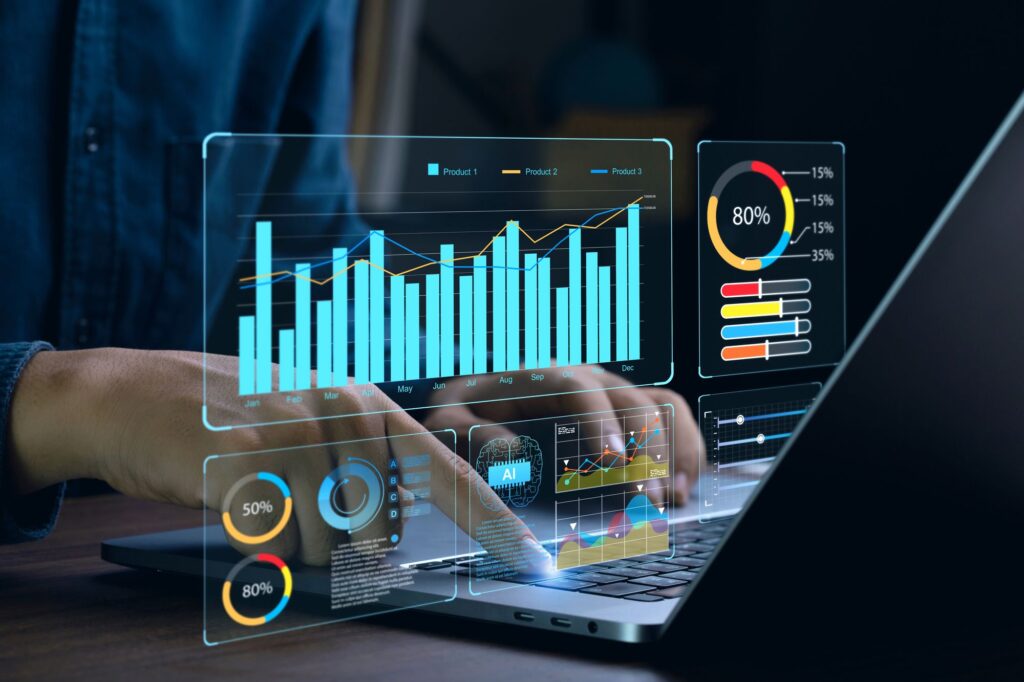In today’s data-driven world, the ability to analyze and interpret data is a valuable skill for professionals across industries. Whether you’re in marketing, finance, healthcare, or IT, understanding and utilizing data analysis tools can unlock insights that drive better decisions, improve strategies, and foster innovation. In this blog, we’ll explore the top 5 data analysis tools that every professional should know to enhance their analytical capabilities.

1. Microsoft Excel – The Classic for Basic Analysis
Despite the rise of advanced analytics tools, Microsoft Excel remains the go-to tool for many professionals. With its powerful spreadsheet features, Excel offers a wide range of functionalities for data entry, visualization, and basic analysis. Some of its key features include:
- Pivot Tables: Quickly summarize and analyze large datasets.
- Formulas: Perform complex calculations and data manipulation.
- Charts and Graphs: Create visual representations of your data to communicate findings effectively.
Why You Should Know It: Excel is widely used across industries, and its simplicity makes it ideal for quick data analysis. It’s also a great tool for beginners who want to dive into the world of data analytics before moving on to more specialized software.
2. Tableau – Powerful Visualization Tool
Tableau is a leading data visualization tool that helps users transform raw data into interactive, visually appealing charts, graphs, and dashboards. With its drag-and-drop interface, Tableau enables users to connect to various data sources, analyze trends, and present findings in a way that’s easy to understand.
- Data Integration: Connect to various data sources, including spreadsheets, databases, and cloud services.
- Real-Time Analytics: Tableau allows users to analyze data in real time and generate dynamic reports.
- Advanced Visualizations: Create detailed and interactive visualizations to uncover patterns and insights.
Why You Should Know It: Tableau is widely used for creating interactive dashboards and reports, which are critical for business intelligence and presenting data in a compelling way. Its ability to integrate data from multiple sources makes it a versatile tool for professionals in almost any field.
3. R – A Statistical Programming Language
For those seeking a more technical and customizable approach to data analysis, R is a powerful programming language and environment specifically designed for statistics and data analysis. R provides a wide range of statistical tools for data mining, data visualization, and advanced analysis.
- Extensive Libraries: Access to a wide array of packages for statistical analysis, machine learning, and more.
- Data Visualization: Create highly customizable and complex visualizations with libraries like ggplot2.
- Open Source: R is free to use, making it an accessible tool for individuals and organizations.
Why You Should Know It: If your role requires deep statistical analysis or working with large datasets, learning R will open up advanced analytical capabilities. It’s especially useful for professionals in fields like data science, academia, and research.
4. Google Analytics – Essential for Web Data Analysis
Google Analytics is an essential tool for professionals working in digital marketing, eCommerce, and website management. It provides insights into how visitors interact with your website, helping businesses optimize their online presence and marketing strategies.
- Website Traffic: Track user behavior, including where visitors come from, which pages they visit, and how long they stay.
- Conversion Tracking: Monitor conversions and set up goals to track the effectiveness of marketing campaigns.
- Segmentation: Break down traffic by demographics, behavior, and acquisition channels.
Why You Should Know It: Google Analytics is critical for understanding website performance, user engagement, and campaign effectiveness. It’s a must-have tool for professionals in marketing, product management, and business development who want to optimize online strategies and improve user experiences.
5. Power BI – Microsoft’s Data Visualization Tool
Power BI is another powerful business analytics tool from Microsoft that allows professionals to visualize data, share insights, and collaborate on reports. It is designed to work seamlessly with Microsoft products, making it an excellent choice for organizations already using Excel, Azure, or other Microsoft tools.
- Real-Time Dashboards: Visualize data from various sources in real-time and share with stakeholders.
- Data Integration: Easily connect to a wide range of data sources like Excel, cloud services, and SQL databases.
- Collaborative Features: Share reports and collaborate with team members directly within the tool.
Why You Should Know It: Power BI is perfect for professionals who need to create business intelligence reports and dashboards. It’s an accessible tool for those who are familiar with Microsoft products and offers an easy entry point into more advanced data analysis.
Conclusion
The ability to analyze data and generate insights is a key skill in today’s professional landscape. Whether you’re working with spreadsheets, creating interactive dashboards, or diving deep into statistical models, the right data analysis tools can make all the difference. Excel, Tableau, R, Google Analytics, and Power BI are all essential tools that every professional should know to stay ahead in the fast-evolving world of data.
Each of these tools has its strengths and is tailored to different types of analysis and industries. By mastering them, you’ll be equipped to turn raw data into actionable insights and drive smarter decisions in your organization.
